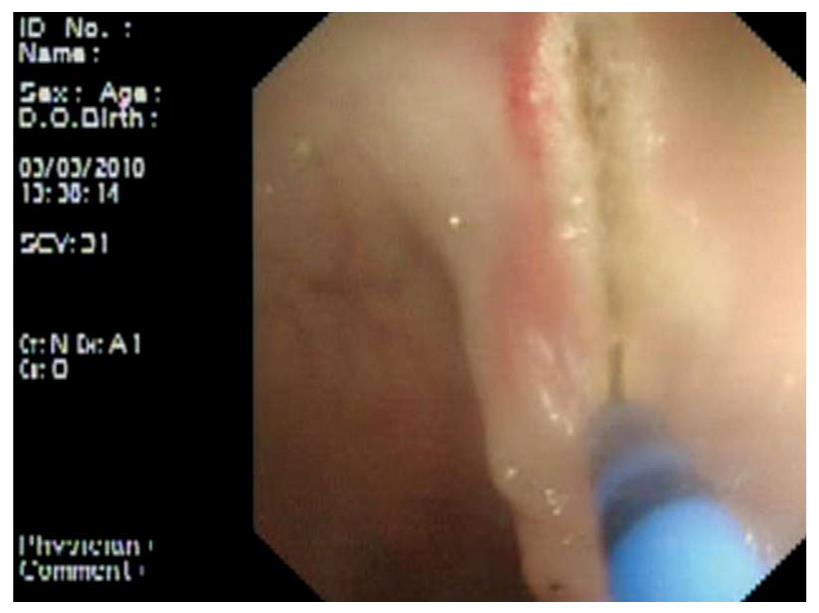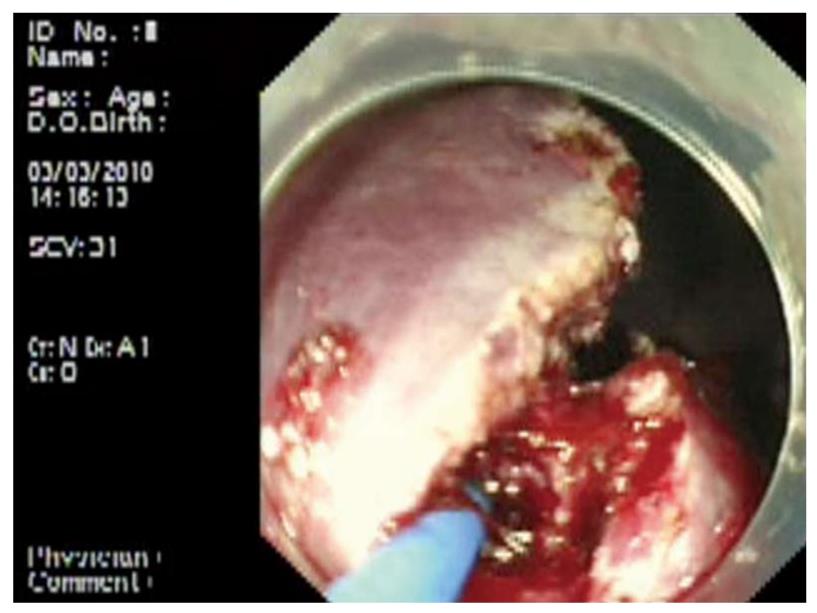Copyright
©2011 Baishideng Publishing Group Co.
World J Gastroenterol. Feb 21, 2011; 17(7): 926-931
Published online Feb 21, 2011. doi: 10.3748/wjg.v17.i7.926
Published online Feb 21, 2011. doi: 10.3748/wjg.v17.i7.926
Figure 1 Colostomy on anterior wall of rectal junction and sigmoid colon.
At the beginning of trans-annual natural orifice transluminal endoscopic surgery procedure, entry into the peritoneal cavity was via a 15-mm linear incision using the hook knife (cutting width set at 6 units and cutting interval set at 1 unit). The ideal access point was the junction of rectum and sigmoid colon at a distance of 15-20 cm away from the anus.
Figure 2 Hydro-dissection of liver segment in natural orifice transluminal endoscopic surgery procedure.
Hepatic parenchyma dissection was performed using the water-jet hybrid knife kept away from the tissue in a no-touch fashion and perpendicular to but not tangentially against the predetermined surface, keeping in a smooth, reproducible, back-and-forth waving motion. A 4-mm transparent distance soft cap was mounted onto the tip of the endoscope for holding up the desired surface, subsequently avoiding the deviation in the direction of the water-jet.
Figure 3 Hydro-dissection of liver segment in open procedure.
Hepatic parenchyma dissection was performed using the water-jet hybrid knife in a similar natural orifice transluminal endoscopic surgery procedure, except that the 4-mm transparent distance soft cap was not used.
Figure 4 A resected liver segment compared with the reserved part.
A resected liver segment was picked out with white gauze.
Figure 5 Microscopic findings of water-jet dissection in liver tissues (HE stain, × 40).
A smooth and gentle cutting margin was presented. The cutting width at the bottom of the cut was similar to the dissection width at tissue surface, with little vessel damage.
Figure 6 Thermal alterations due to intra-operative coagulation (HE stain, × 100).
Removal of the liver capsule could be seen in an example of thermal damage.
- Citation: Shi H, Jiang SJ, Li B, Fu DK, Xin P, Wang YG. Natural orifice transluminal endoscopic wedge hepatic resection with a water-jet hybrid knife in a non-survival porcine model. World J Gastroenterol 2011; 17(7): 926-931
- URL: https://www.wjgnet.com/1007-9327/full/v17/i7/926.htm
- DOI: https://dx.doi.org/10.3748/wjg.v17.i7.926














